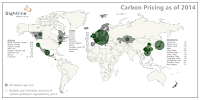This map shows the steady, inexorable spread of carbon pricing.
Most people who have given climate change policy any thought agree that it is important to put a price on greenhouse gas emissions. They are a form of harmful waste; those producing the waste should pay for the harms. (There’s plenty of debate over just how central pricing is to a serious climate strategy, but very little debate that it should play some role.)
That policy consensus has been in place for quite a while. It seems the political world is beginning to catch up.
The sustainability think tank Sightline has just updated its map of carbon pricing systems across the world. Things have gotten quite lively. Here’s a link to an animated version:
The big recent news is China, of course. In July its carbon cap-and-trade system — which has been tested in nine provinces for several years — will go national, effectively doubling the world’s priced carbon. (That’s the giant bubble on the map.) At that point, fully a quarter of the world’s carbon emissions will be priced at one level or another. A quarter!
Action in the past few years has been fast and furious. Sightline’s Kristin Eberhard summarizes:
In 2015 Portugal launched a carbon tax, and South Korea implemented a cap-and-trade program. California expanded its cap-and-trade program, initially launched in 2012, to cover 85 percent of it GHG emissions.
After abolishing its carbon price in 2014, Australia launched a new “safeguard mechanism”—a modified form of cap-and-trade—in 2016. In addition to its carbon tax, which has been in place since 2008, in 2016 British Columbia put a limit and price on pollution from industrial facilities (especially targeting coal-fired power plants and liquefied natural gas facilities). In 2018, BC will expand its carbon tax to cover fugitive emissions and forest slash-pile burning and raise the tax by $5 per year.
The United States-shaped hole in the fight against climate change is increasingly conspicuous. In 2017 Ontario, Canada, launched a cap-and-trade program, and Alberta, Canada, launched a new carbon tax for transportation and heating fuel emissions. Canada’s federalist experiment around carbon pricing paid off: four different provinces are running four different programs, and now the federal government is ready to implement a national price in 2018. But the federal requirements leave plenty of room for each province to tailor its own solution. Mexico will also launch a national carbon price in 2018.
Read more at 40 Countries Are Making Polluters Pay for Carbon Pollution. Guess Who's Not.

No comments:
Post a Comment